Novel anti-adipogenic activity produced by human fibroblasts
- PMID: 20554910
- PMCID: PMC2944318
- DOI: 10.1152/ajpcell.00451.2009
Novel anti-adipogenic activity produced by human fibroblasts
Abstract
Fatty tissue is generally found in distinct "depots" distributed throughout the human body. Adipocytes from each of the various depots differ in their metabolic capacities and their responses to environmental stimuli. Although a general understanding of the factors responsible for adipogenic transformation has been achieved, much is not understood about the mechanisms of adipose tissue deposition and the phenotypes of the adipocytes found within each depot. A clue to the factors regulating fat deposition may come from studies of adipogenesis using primary human orbital fibroblasts from patients with thyroid eye disease, a condition in which intense inflammation leads to expansion of orbital adipose tissue via differentiation of fibroblasts to adipocytes. We have previously demonstrated that adipogenesis of orbital fibroblasts is negatively correlated with cellular expression of the Thy-1 surface marker. In this study, we developed a novel imaging flow cytometric approach for the assessment of adipogenesis to test the hypothetical dependence of adipogenic potential on lack of Thy-1 expression. Using this technique, we learned that Thy-1-positive fibroblasts are, in fact, capable of differentiating into adipocytes but are less likely to do so because they secrete a paracrine anti-adipogenic factor. It is possible that such a factor plays an important role in the prevention of excess fat deposition in the normal orbit and may even be exploited as a therapy for the treatment of obesity, a major worldwide health concern.
Figures
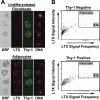
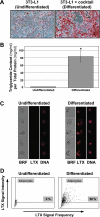

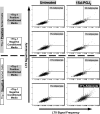
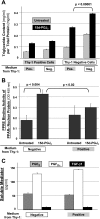
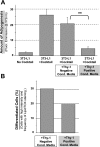

Similar articles
-
Thy1 (CD90) controls adipogenesis by regulating activity of the Src family kinase, Fyn.FASEB J. 2015 Mar;29(3):920-31. doi: 10.1096/fj.14-257121. Epub 2014 Nov 21. FASEB J. 2015. PMID: 25416548 Free PMC article.
-
Activated human T lymphocytes express cyclooxygenase-2 and produce proadipogenic prostaglandins that drive human orbital fibroblast differentiation to adipocytes.Am J Pathol. 2006 Oct;169(4):1183-93. doi: 10.2353/ajpath.2006.060434. Am J Pathol. 2006. PMID: 17003477 Free PMC article.
-
FTO influences adipogenesis by regulating mitotic clonal expansion.Nat Commun. 2015 Apr 17;6:6792. doi: 10.1038/ncomms7792. Nat Commun. 2015. PMID: 25881961 Free PMC article.
-
Thy-1: more than a marker for mesenchymal stromal cells.FASEB J. 2019 Jun;33(6):6689-6696. doi: 10.1096/fj.201802224R. Epub 2019 Feb 27. FASEB J. 2019. PMID: 30811954 Review.
-
Molecular Regulation of Adipogenesis and Potential Anti-Adipogenic Bioactive Molecules.Int J Mol Sci. 2016 Jan 19;17(1):124. doi: 10.3390/ijms17010124. Int J Mol Sci. 2016. PMID: 26797605 Free PMC article. Review.
Cited by
-
A Role for Bradykinin Signaling in Chronic Vulvar Pain.J Pain. 2016 Nov;17(11):1183-1197. doi: 10.1016/j.jpain.2016.07.007. Epub 2016 Aug 18. J Pain. 2016. PMID: 27544818 Free PMC article.
-
Thy-1 signals through PPARγ to promote lipofibroblast differentiation in the developing lung.Am J Respir Cell Mol Biol. 2012 Jun;46(6):765-72. doi: 10.1165/rcmb.2011-0316OC. Epub 2012 Jan 20. Am J Respir Cell Mol Biol. 2012. PMID: 22268140 Free PMC article.
-
Lipomatous metaplasia identified in rabbits with reperfused myocardial infarction by 3.0 T magnetic resonance imaging and histopathology.BMC Med Imaging. 2013 Jul 1;13:18. doi: 10.1186/1471-2342-13-18. BMC Med Imaging. 2013. PMID: 23815556 Free PMC article.
-
Thy1 (CD90) controls adipogenesis by regulating activity of the Src family kinase, Fyn.FASEB J. 2015 Mar;29(3):920-31. doi: 10.1096/fj.14-257121. Epub 2014 Nov 21. FASEB J. 2015. PMID: 25416548 Free PMC article.
-
CD90 and CD24 Co-Expression Is Associated with Pancreatic Intraepithelial Neoplasias.PLoS One. 2016 Jun 22;11(6):e0158021. doi: 10.1371/journal.pone.0158021. eCollection 2016. PLoS One. 2016. PMID: 27332878 Free PMC article.
References
-
- Baglole CJ, Reddy SY, Pollock SJ, Feldon SE, Sime PJ, Smith TJ, Phipps RP. Isolation and phenotypic characterization of lung fibroblasts. Methods Mol Med 117: 115–127, 2005 - PubMed
-
- Bahn RS, Heufelder AE. Pathogenesis of Graves' ophthalmopathy. N Engl J Med 329: 1468–1475, 1993 - PubMed
-
- Blouin K, Boivin A, Tchernof A. Androgens and body fat distribution. J Steroid Biochem Mol Biol 108: 272–280, 2008 - PubMed
-
- Boyanov MA, Boneva Z, Christov VG. Testosterone supplementation in men with type 2 diabetes, visceral obesity and partial androgen deficiency. Aging Male 6: 1–7, 2003 - PubMed
-
- Crandall DL, Busler DE, Novak TJ, Weber RV, Kral JG. Identification of estrogen receptor beta RNA in human breast and abdominal subcutaneous adipose tissue. Biochem Biophys Res Commun 248: 523–526, 1998 - PubMed
Publication types
MeSH terms
Substances
Grants and funding
LinkOut - more resources
Full Text Sources
Other Literature Sources
Miscellaneous

